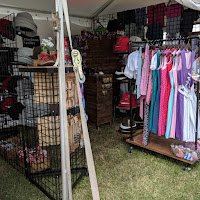For anyone who's ever wondered what it's like selling at festivals, here's some observations I'd love to share. Of course we're talking merchandise here, not food vendors (that's an entirely separate thing).
Vendor Fees
For a weekend festival I typically pay between $125 and $400 for a booth. If the festival has free admission to the general public you can bet they're making their money on higher vendor booth fees. These festivals will attract a larger "general" crowd, but not necessarily the right shoppers if you have a niche product.
Vendor Selection
There are two groups here - juried and non-juried. Juried simply means they are more judicious in their selection, for example they may only want vendors who sell hand-made items, or items that contribute to the festival's overall theme (such as a Christmas market). Non-juried festivals will generally allow any kind of "vendor" including cell phone providers, door & window give-aways, etc. Y'know, the people who are trying to sign you up for crap you don't want - this can sometimes turn shoppers off.
Attendance Size
Free festivals generally draw a much bigger crowd, but as mentioned above this does not typically translate to bigger sales for me. There are festival-service websites that will give you attendance stats for a nominal subscription fee, but I think most festival organizers will provide these to you on request.
Pricing with Sales Tax
Initially I added sales tax at the register. Apparently this annoys a lot of cash buyers and they won't hesitate to tell you that "all the other sellers" have flat pricing. Luckily, Square lets me include the sales tax in the prices (so I raised my prices slightly and rounded off to the nearest number to absorb the sales tax).
You Can't Really Do It Alone...
At least, not for very long. Some days start at 10:00am and go to midnight. Every time you step away from your booth to get food or use the potty you are probably losing sales (and quite possibly some merchandise). I don't really make enough to pay someone else a fair wage on top of accommodations (since most of my festivals are out of town), so I'm very lucky my husband has started going with me. He's free to come and go throughout the day and I think he enjoys some of the festivals, too. Especially the ones with good entertainment!
"Why don't you sell ____?"
I mean, say what you gotta say and get rid of them quickly - they are just going to waste your time and it's not like they would buy that item from you even if you did sell it. Same goes for people complaining about your prices or how they could make it for less. "Okay."
What People Don't Understand
Most of my merch is handmade by me. It's hard not to look at an expense and think "well I'm basically giving away 2 dirndls for free to cover that cost". And those dirndls were not free for me to make. So if a booth fee is $300, then that's two dirndls for $150 each that I have to sell just to "break even" - except, I haven't really broken even because I'm still out the cost of those materials and my time.
Which brings me to people who ask me for a discount on my handmade items. Let me be clear, there is no profit for me to reduce - only the cost of materials (which I have no control over) and my labor. Since I'm not making a salary by standing in that booth, the only money I'm actually earning is a fare wage for my labor. And people who know what I charge will tell you I should be charging more, but it's really hard to compete with junk made in China and sold on Amazon.
Another peeve of mine is consideration for my merchandise. If it were damaged in a storm or by the late night drunk crowds that like to play dress-up it's not like I can just contact a supplier to send me more merchandise in time for my next festival. Insurance may cover my loss, but it would still take me months to rebuild my inventory. And if I had another festival lined up the following weekend I would be screwed.
Most contracts have a clause about when you have to set up, and the hours you must remain open. If you are in breech of your contract you will likely be black-listed from any future participation. So if there is a horrible storm coming and you decide to pack-up and protect your inventory you could still lose that festival permanently.























